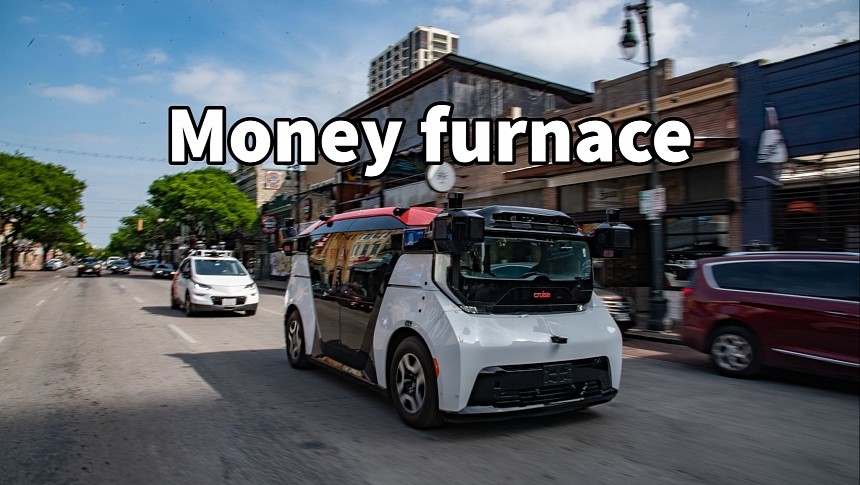GM's Q1 earnings call brought good and bad news for its autonomous driving subsidiary, Cruise. The Robotaxi service is expanding service to daylight hours in San Francisco, but its cash reserves are depleting as it burns cash at a fast rate.
Driverless cars are yet to make a living, and companies operating them are giving up after burning their cash reserves. After Ford and Volkswagen pulled the plug on Argo AI, other robotaxi companies are scaling down their operations. Waymo has laid off 8% of its workforce this year in a bid to cut losses. Meanwhile, GM's Cruise has remained bullish on its prospects, despite losing money like everyone else.
Cruise was the first robotaxi company to get a commercial license in San Francisco and has since expanded operations in the city and other areas. This hasn't changed the fundamental economics that it's still burning cash and will likely continue to do so for the foreseeable future. In the first quarter of the year, the losses amounted to $561 million, as confirmed by the company's CEO, Kyle Vogt, during GM's Q1 earnings call.
Cruise's cash reserves dropped from $4.12 billion at the end of Q1 2022 to $2.47 billion a year later. At more than $500 million a quarter, this leaves Cruise about a year worth of resources to continue operations. After that, GM would have to choose whether it takes the hit and keeps Cruise operating or limits losses and integrates Cruise into its operations, as Ford did with Argo AI.
GM reported solid financial results for the first quarter but will not support losses at Cruise in the long run. The robotaxi company earned just $30 million in revenue during the first three months. However, most of the money came from interests and other non-operating sources. Despite modest results, Cruise's CEO is confident his company is on track to reach $1 billion in revenue by 2025 and $50 billion by 2030.
Cruise currently operates robotaxi services in San Francisco, Phoenix, and Austin and is preparing to launch in Dallas. San Francisco operations are also expanding to new areas of the city and daylight hours. Cruise wants to offer a 24/7 service in San Francisco, as announced by Kyle Vogt. This is rolling out gradually, first to Cruise employees ("Cruisers") and later to paying customers.
Cruise has added more robotaxis to its fleet in the first quarter to support its expansion plans. The GM subsidiary now operates 242 driverless cars, up 86% from a year ago. These have passed the 1.5-million mark of driverless rides, with up to 1,000 paid trips each day. The company has also started building the Origin driverless pods at its Factory Zero in Detroit and expects to begin testing later this year in Austin. Cruise Origin pods will replace the Chevrolet Bolt in Cruise's fleet, especially as GM announced ending the production of the affordable EV.
Cruise was the first robotaxi company to get a commercial license in San Francisco and has since expanded operations in the city and other areas. This hasn't changed the fundamental economics that it's still burning cash and will likely continue to do so for the foreseeable future. In the first quarter of the year, the losses amounted to $561 million, as confirmed by the company's CEO, Kyle Vogt, during GM's Q1 earnings call.
Cruise's cash reserves dropped from $4.12 billion at the end of Q1 2022 to $2.47 billion a year later. At more than $500 million a quarter, this leaves Cruise about a year worth of resources to continue operations. After that, GM would have to choose whether it takes the hit and keeps Cruise operating or limits losses and integrates Cruise into its operations, as Ford did with Argo AI.
GM reported solid financial results for the first quarter but will not support losses at Cruise in the long run. The robotaxi company earned just $30 million in revenue during the first three months. However, most of the money came from interests and other non-operating sources. Despite modest results, Cruise's CEO is confident his company is on track to reach $1 billion in revenue by 2025 and $50 billion by 2030.
Cruise currently operates robotaxi services in San Francisco, Phoenix, and Austin and is preparing to launch in Dallas. San Francisco operations are also expanding to new areas of the city and daylight hours. Cruise wants to offer a 24/7 service in San Francisco, as announced by Kyle Vogt. This is rolling out gradually, first to Cruise employees ("Cruisers") and later to paying customers.
Cruise has added more robotaxis to its fleet in the first quarter to support its expansion plans. The GM subsidiary now operates 242 driverless cars, up 86% from a year ago. These have passed the 1.5-million mark of driverless rides, with up to 1,000 paid trips each day. The company has also started building the Origin driverless pods at its Factory Zero in Detroit and expects to begin testing later this year in Austin. Cruise Origin pods will replace the Chevrolet Bolt in Cruise's fleet, especially as GM announced ending the production of the affordable EV.
Well folks, we did it. I have been waiting for this day for almost 10 years.
— Kyle Vogt (@kvogt) April 25, 2023
I am proud to announce @Cruise is now running 24/7 across all of San Francisco!
This is a pivotal moment for our business.
Let me tell you why ????(1/6) pic.twitter.com/UqCMgozrWX






